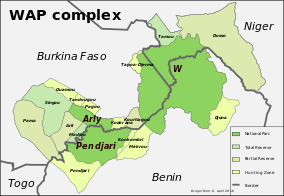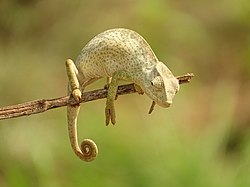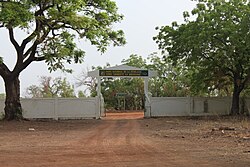Pendjari nationalpark
| Pendjari nationalpark | |||||||||||||||||
|---|---|---|---|---|---|---|---|---|---|---|---|---|---|---|---|---|---|
IUCN kategori II (nationalpark) | |||||||||||||||||
 | |||||||||||||||||
| IUCN Protected Areas of the WAP complex | |||||||||||||||||
| Sted | Benin, Vestafrika | ||||||||||||||||
| Nærmeste by | Tanguieta | ||||||||||||||||
| Koordinater | 11°3′N 1°31′Ø / 11.050°N 1.517°Ø | ||||||||||||||||
| https://www.african-parks.org/the-parks/pendjari | |||||||||||||||||
| |||||||||||||||||
Pendjari nationalpark er en nationalpark der ligger i det nordvestlige Benin, der støder op til Arli National Park i Burkina Faso. Nationalparken er opkaldt efter Pendjarifloden (Oti-floden) og er kendt for sit dyreliv. Nationalparken er hjemsted for nogle af de sidste bestande af storvildt som den afrikanske skovelefant, løve, flodhest, afrikansk bøffel og forskellige antilopearter i Vestafrika. Parken er også berømt for sin rigdom på fugle.
Pendjari nationalpark har et areal på 2.755 km2 og er en del af WAP-komplekset (W - Arli - Pendjari), et stort beskyttet område i Benin, Burkina Faso og Niger. Bakker og klipper i Atakora-området er synlige fra parken.
I marts 2009 blev parken foreløbigt nomineret til UNESCO 's Verdensarvsliste, (tentativlisten) og i juli 2017 blev den officielt optaget på verdensarvslisten som en del af en transnational udvidelse af WAP-komplekset.
Økologi
Områdets klippeklipper er tyndt bevokset med Burkea africana, Detarium microcarpum, Lannea acida, Sterculia setigera og Combretum ghasalense. På den dybe jord på nogle af toppene og Atakora-skråningen er der en større variation af træer med Isoberlinia doka og Afzelia africana. Pendjari-floden er omgivet af skov. Parken omfatter både de sudanske og guineanske savanner med græsarealer domineret af Acacia sieberiana og Mitragyna inermis eller Terminalia macroptera. Den årlige nedbør er cirka 1.100 mm. Parken er åben året rundt, selvom visse dele af parken kan være utilgængelige fra juni til november på grund af kraftig regn.

Pattedyr





Pendjari nationalpark har en relativt stor bestand af elefanter, som var stabil gennem de sidste årtier og talte mere end 800 individer mellem 2005 og 2010.[1] WAP-kompleksets elefantbestand er mere end 3.800, hvilket gør det til den største elefantkoncentration i hele det vestlige Afrika.[2] Den næststørste art i parken er flodhest. Der er også store populationer af adskillige andre store planteædere som afrikanske bøfler (Syncerus caffer brachyceros; ca. 2.700 dyr i 2000), vestlige koantilope (Alcelaphus buselaphus major; ca. 1.500 i 2000), hesteantilope (2.000 i år 2.000), ca. kobantilope (ca. 2.600 i 2000) og vortesvin. Nogle andre antilopearter som korrigum (Damaliscus lunatus korrigum også kendt som senegalisisk koantiope), kudu og rørbuk er relativt sjældne. Mindre skedehornede er grårygget dykkerantilope, oribi og almindelig dykkerantilope. Primater er repræsenteret af anubisbavianen, husaraben og tantalus-aben.[3]
Et af de sjældneste store rovdyr i det beskyttede område er den nordvestafrikanske gepard (Acinonyx jubatus hecki). Fra 2007 var der kun omkring 5-13 individer tilbage i nationalparken og naboområdet W National Park. I 2009 omfattede løvebestanden (Panthera leo leo) i WAP-komplekset omkring 100 dyr og var muligvis den største i Vestafrika på det tidspunkt.[4]
Den truede vestafrikanske vildhund (Lycaon pictus manguensis) blev registreret i Pendjari nationalpark under en undersøgelse i april 2000, såvel som afrikansk leopard, plettet hyæne, stribet sjakal og afrikansk sivet.[3]
Antallet af vandbukke (Kobus ellipsiprymnus defassa) faldt fra omkring 3.000 i 1970'erne til 120 i 2004.[5]
Fugle
Hættegribben (Necrosyrtes monachus) er hjemmehørende i det fredede område, men i et lille antal.[6]
Parken er kendt for sin overflod af fuglearter.[7] Der findes omkring 300 forskellige arter i parken. Steppehøg (Circus macrourus) og lille tårnfalk (Falco naumanni) er af og til registreret, og der er enkelte isolerede registreringer for øregrib (Torgos tracheliotus). Rævefalk (Falco alopex) er ikke ualmindelig, mens svaleglente (Chelictinia riocourii) er en almindelig gæst i tørsæsonen. Dværgørn (Hieraaetus pennatus) er også blevet registreret her. BirdLife bemærker, at "Pendjari er bemærkelsesværdig for store iøjnefaldende arter såsom afrikansk gabenæb (Anastomus lamelligerus), abdims stork (Ciconia abdimii), sadelnæbbet stork (Ephippiorhynchus senegalensis) og sæsonmæssigt flokke på op til 60 europæiske storke (Ciconia ciconia). Den afrikansk flodørn (Haliaeetus vocifer) og Pels fiskeugle (Scotopelia peli) kan også findes.
Se også
Referencer
- ^ Bouché, P.; Douglas-Hamilton, I.; Wittemyer, G.; Nianogo, A.J.; Doucet, J.L.; Lejeune, P. & Vermeulen, C. (2011). "Will Elephants Soon Disappear from West African Savannahs?". PLOS ONE. 6 (6): e20619. Bibcode:2011PLoSO...620619B. CiteSeerX 10.1.1.290.2335. doi:10.1371/journal.pone.0020619. PMC 3120750. PMID 21731620.
- ^ Clerici, N.; Bodini, A.; Eva, H.; Grégoire, J.M.; Dulieu, D. & Paolini, C. (2007). "Increased isolation of two Biosphere Reserves and surrounding protected areas (WAP ecological complex, West Africa)". Journal for Nature Conservation. 15 (1): 26-40. doi:10.1016/j.jnc.2006.08.003.
- ^ a b Sinsin, B.; Tehou, A.C.; Daouda, I.; Saidou, A. (2002). "Abundance and species richness of larger mammals in Pendjari National Park in Benin". Mammalia. 66 (3): 369-380. doi:10.1515/mamm.2002.66.3.369. S2CID 83686235.
- ^ Henschel, P.; Azani, D.; Burton, C.; Malanda, G.; Saidu, Y.; Sam, M.; Hunter, L. (2010). "Lion status updates from five range countries in West and Central Africa" (PDF). Cat News. 52: 34-39. Arkiveret fra originalen (PDF) 30. juli 2013. Hentet 5. november 2018.
- ^ Kassa, B.; Libois, R.; Sinsin, B. (2007). "Diet and food preference of the waterbuck (Kobus ellipsiprymnus defassa) in the Pendjari National Park, Benin". African Journal of Ecology. 46 (3): 303-310. doi:10.1111/j.1365-2028.2007.00827.x.
- ^ Thiollay, J.M. (2006). "The decline of raptors in West Africa: long-term assessment and the role of protected areas". Ibis. 148 (2): 240-254. doi:10.1111/j.1474-919X.2006.00531.x.
- ^ Dasgupta, S. (2018-02-01). "$23.5 million funding pledge aims to protect critical West African national park". Mongabay. Hentet 2018-02-01.
Yderligere læsning
- Assédé, EPS, Adomou, AC & B. Sinsin (2012) Magnoliophyta, Biosfærereservat i Pendjari, Atacora-provinsen, Benin. Tjekliste 8 (4): 642–661. [1]
- Hogan, CM 2009. Painted Hunting Dog: Lycaon pictus, GlobalTwitcher.com, red. N. Stromberg
- Legba, F. (2005) Bidrag de la vegetation des collines de la zone cynegetique et du Parc National de la Pendjari du Benin comme miljø kadre og miljø ressource de la faune sauvage. Disse Ing. Agr. , Université d´Abomey-Calavi, Cotonou. 121 S.
- Nago, SGA (2005) Diversité des amphibiens dans les terroirs riverrains à la Zone Cynogénétique de la Pendjari. Mémoire de diplôme d´étude approfondies (DEA), Université d´Abomey-Calavi, Cotonou.
- UNDP/GEF (2005): Forbedring af effektiviteten og katalysering af bæredygtigheden af W-Arly-Pendjari (WAP) beskyttede områdesystem. UNEP projektdokument PIMS 1617. [2]
- Woodroffe, R., Ginsberg, JR og DW Macdonald. 1997. Den afrikanske vilde hund: statusundersøgelse og bevaringshandlingsplan, IUCN/SSC Candid Specialist Group, udgivet af IUCN,ISBN 978-2-8317-0418-0 sider 166
Eksterne henvisninger
Medier brugt på denne side
Forfatter/Opretter: Marc Auer, Licens: CC BY 2.0
Elephants at Pendjari National Park, Benin
Forfatter/Opretter: Farid AMADOU BAHLEMAN , Licens: CC BY-SA 4.0
Very fast in the race, the hartebeest can run from 75 km / h on average and up to 90 km / h in peak to escape its predators like lion.
Forfatter/Opretter: Farid AMADOU BAHLEMAN , Licens: CC BY-SA 4.0
This bird is easily recognized by its black and white speckled plumage (which gave it its name), its large and long black beak and its hoopoe.
This bird is easily recognized by its black and white speckled plumage (which gave it its name), its large and long black beak and its hoopoe.
It has a sexual dimorphism: the male has two black pectoral bands (one more than the female). in this photo we have a female.
It lives both around fresh and salt water points and feeds on fish, crustaceans, aquatic insects and small arthropods. When hunting, it can catch multiple prey in one flight. It most often hovers before diving abruptly to capture its prey.Forfatter/Opretter: Gregor Rom, Licens: CC BY-SA 4.0
Die Pendjaririvier (ook Oti-) tydens die droëseisoen. Dit vorm die grens tussen Burkina Faso (Arly Nasionale Park op regteroewer) en Benin (Pendjari Nasionale Park op linkeroewer).
Forfatter/Opretter: Farid AMADOU BAHLEMAN , Licens: CC BY-SA 4.0
natural habitats are subtropical or tropical humid lowland forests, subtropical or tropical dry shrubs, rivers, intermittent rivers, shrub-dominated wetlands, swamps, freshwater lakes, freshwater lakes intermittent, freshwater marshes, intermittent freshwater marshes and freshwater springs
Forfatter/Opretter: Fawaz.tairou, Licens: CC BY-SA 3.0
Porte d'entrée du parc National de la Pendjari, au nord-ouest du Bénin.
Forfatter/Opretter: Farid AMADOU BAHLEMAN , Licens: CC BY-SA 4.0
Acraea caecilia is now classified in the family Nymphalidae (tetrapod butterflies – first pair of reduced legs) and in the subfamily Heliconiinae. The male, with unmarked abdomen, is seen above.
(c) Baliola, CC BY-SA 3.0
Vergesig oor die boomveld van die Pendjari Nasionale Park in Benin, vanaf 'n voetheuwel van die Atakorabergreeks.
Forfatter/Opretter: Michozounou franck Wilfried, Licens: CC BY-SA 4.0
The emblematic chameleon of the late General the late Mathieu Kerekou in Pendjari National Park (found using the coordinates)
Forfatter/Opretter: Jonas Van de Voorde, Licens: CC BY-SA 3.0
West African male lion from Pendjari National Park, Benin.
Forfatter/Opretter: Gregor Rom, Licens: CC BY-SA 4.0
nationalpark pendjari - büffel
Forfatter/Opretter: Gregor Rom, Licens: CC BY-SA 4.0
WAP complex (National parcs W, Arly and Pendjari) in Benin, Burkina Faso and Niger
Forfatter/Opretter: Farid AMADOU BAHLEMAN , Licens: CC BY-SA 4.0
t is a reptile, which needs warmth and a fairly high humidity level. He is shy but easy to handle, He eats anything that is insect that passes in front of him. It is likely to be found especially in trees since it is an arboreal species around the Biophère de la Pendjari reserve.
Forfatter/Opretter: Farid AMADOU BAHLEMAN , Licens: CC BY-SA 4.0
The African toad is a carnivorous amphibian that pulls its long, sticky tongue out of its mouth at incredible speeds to catch and secure its prey. It also helps the toad to hold onto its catch while it tries to eat it. The African toad mainly hunts small invertebrates including insects, worms and spiders that run among the debris of the forest floor. Like other toads, the African toad is a semi-aquatic animal, although it is most commonly found in the water when the female lays her eggs. Much like other tropical toads, the African toad spends most of its life walking, jumping or running on the ground, where it is able to find plenty of food and water
Forfatter/Opretter: Gregor Rom, Licens: CC BY-SA 4.0
nationalpark pendjari - kuhantilopen am mare bali
























